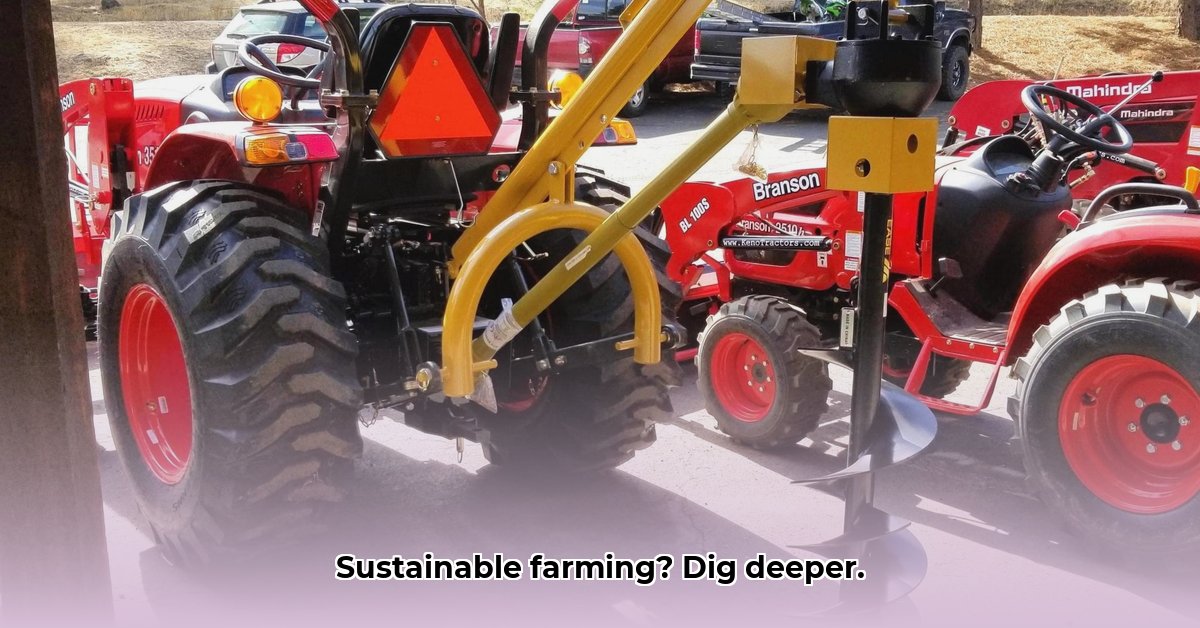
Choosing the Right Tractor-Mounted Post Hole Digger for Your Sustainable Farm
Digging post holes is a fundamental task in sustainable agriculture, impacting everything from fencing and tree planting to vineyard establishment. While labor-intensive by hand, a tractor-mounted post hole digger (PHD) significantly boosts efficiency and reduces the environmental impact associated with manual labor. This guide provides actionable steps to select and effectively utilize a PHD tailored for your unique sustainable farming practices. For more information on PTO shafts, see this helpful guide.
Matching Your Digger to Your Tractor: Ensuring Compatibility and Safety
Before considering specific features, confirm compatibility with your tractor. This critical step prevents costly mistakes and ensures safe operation.
Tractor Horsepower and Three-Point Hitch
Your tractor's horsepower directly influences the digger's capability. Insufficient power leads to frequent stalling, especially in challenging soil conditions. Check your tractor's manual to determine its horsepower rating and match it to the PHD's power requirements. Equally crucial is confirming compatibility with your tractor's three-point hitch system, the mechanism connecting the digger to the tractor. Incorrect matching may result in unsafe operation or damage to both the tractor and the PHD.
Power Take-Off (PTO) Shaft Considerations
The PTO shaft transmits power from the tractor to the PHD. Mismatched PTO shafts – incorrect speed or diameter – represent a significant safety hazard. Always verify compatibility and ensure the use of appropriate safety guards. Never operate the PTO without the appropriate guards in place. Ignoring this precaution could lead to serious injury. Dr. Amelia Hernandez, Agricultural Engineering Professor at the University of California, Davis, emphasizes, "PTO shaft safety is non-negotiable. Always ensure proper shielding and alignment to prevent catastrophic accidents."
Auger Bit Selection: Optimizing for Different Tasks and Soil Types
The auger bit is the digging component; its selection directly impacts efficiency and the long-term cost of operation.
Diameter and Depth: Choosing the Right Size
Auger bit diameter determines hole size. Larger diameters are efficient for fence posts; smaller ones offer better precision for tree planting or smaller projects, such as installing drip irrigation, allowing for greater pinpoint accuracy. Bit depth must accommodate the full length your post needs to go into the ground. For instance, deep-rooted trees necessitate deeper bits.
Material and Durability: Balancing Cost and Lifespan
Hardened steel bits are costlier upfront, but their superior durability translates into lower long-term replacement costs. Softer materials might seem cheaper but may require frequent replacements, negating the initial cost savings. The choice is driven by soil type and frequency of use: hardened steel is ideal for frequent use and challenging soil conditions.
Gearbox Ratios and Torque: Matching Power to Soil Conditions
The gearbox controls the auger's speed and power (torque). Lower gear ratios deliver greater torque, essential for dense or rocky soils, though at a slower digging speed. Conversely, higher gear ratios are faster but demand easier soil conditions. Choosing the right ratio maximizes digging efficiency, preventing unnecessary stress on the tractor and the PHD. "A well-matched gearbox is crucial," states Mark Olsen, a seasoned farmer and equipment specialist in Iowa, "It's the difference between a smooth operation and a frustrating struggle."
Budget and Long-Term Costs: A Sustainable Perspective
Sustainable farming demands careful evaluation of the total cost of ownership (TCO), encompassing initial purchase, maintenance, repairs, and auger bit replacements.
Initial Cost vs. Long-Term Value: High-quality equipment often costs more initially, yet reduces the long-term cost per project by increasing the lifespan of the machine and decreasing maintenance.
New vs. Used Equipment: A cost-effective entry point can be found in used equipment if the machine has been properly maintained. Thorough inspection by a qualified mechanic is crucial before purchasing used equipment.
Safety Features: Implementing Preventative Measures
Prioritizing safety is crucial for both productivity and worker well-being.
Shear Pins: These safety devices protect against damage by shearing (breaking) under excessive force, preventing potentially costly damage to the gearbox. Always carry spares.
Emergency Shut-Off: Quick access to an emergency shut-off is critical for immediate stopping of the auger in the event of an emergency.
Protective Guards: Ensuring that all safety guards are in place and functioning correctly before each use is essential to protect the operator from the moving parts of the digger.
Step-By-Step Operation and Maintenance: Maximizing Lifespan and Efficiency
Proper operation and maintenance are essential for extending equipment life and minimizing downtime.
Pre-Operation Checks: Start the tractor, then engage the PTO shaft slowly to avoid any sudden jerks, then lower the auger into the ground gently.
Operation: Increase engine speed steadily. When complete, raise the auger gently and remove the soil.
Post-Operation Cleaning and Maintenance: Clean dirt and debris from all parts and lubricate accordingly.
Sustainable Considerations: Minimizing Environmental Impact
Sustainable farming incorporates environmental awareness throughout.
Locally Sourced Equipment: Purchasing locally sourced equipment supports local businesses and reduces transportation emissions which supports sustainable practices.
Durable Equipment: Choosing durable, long-lasting tools minimizes waste and reduces the need for frequent replacements, thereby reducing your environmental impact.
Reduced Fuel Consumption: Efficient digging reduces fuel usage, decreasing emissions and operating expenses.
Conclusion: Making Informed Decisions for a Thriving Farm
Selecting the right tractor-mounted post hole digger is a multifaceted process. By carefully considering tractor compatibility, auger bit selection, gearbox ratios, long-term cost, safety features, and sustainable practices, you can make an informed decision that optimizes both efficiency and environmental responsibility. This ensures your farm operates sustainably, profitably, and safely for years to come.